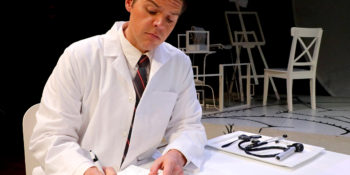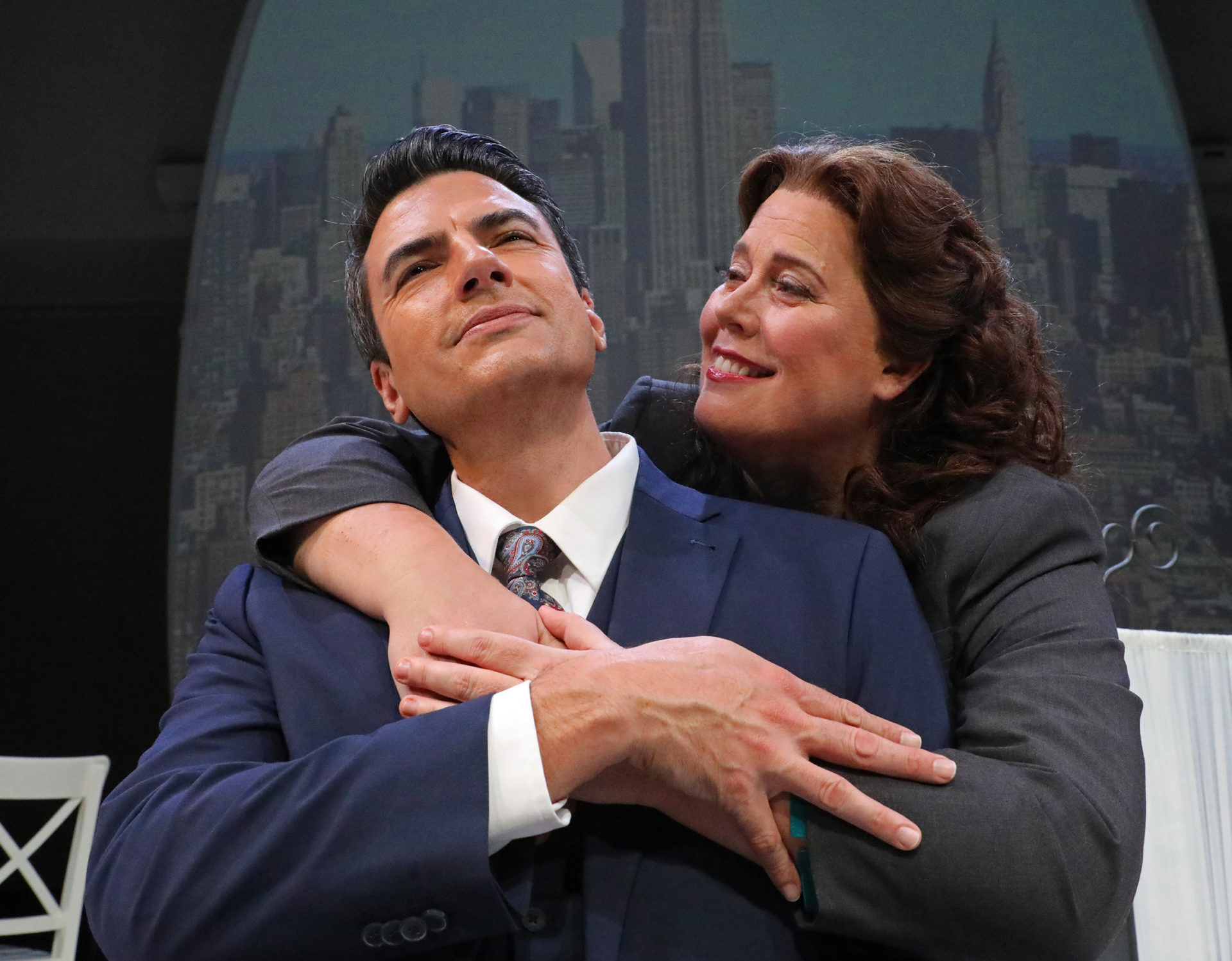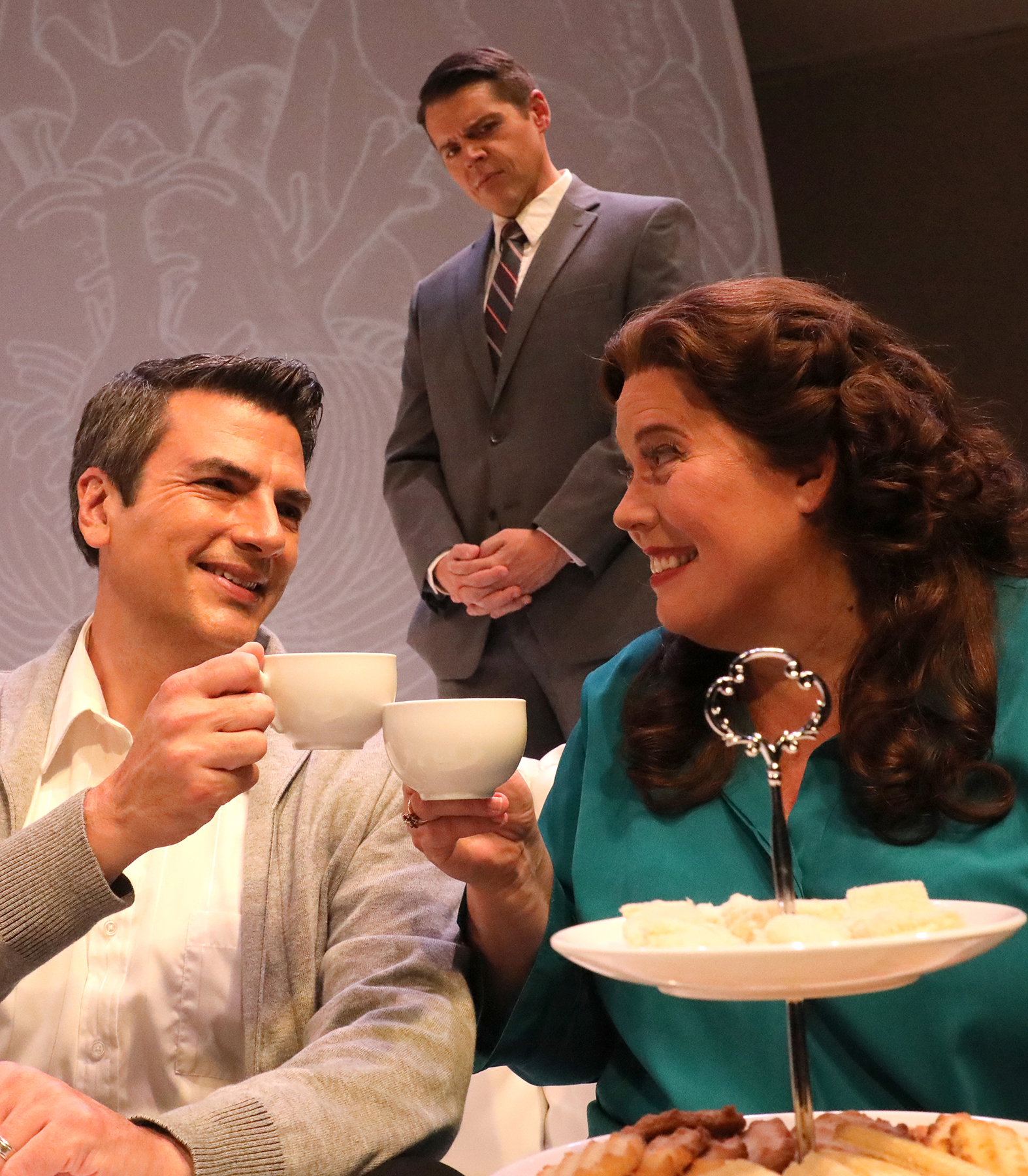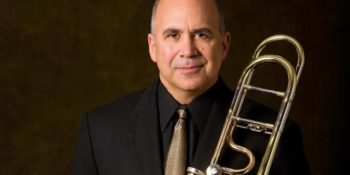The MCR Interview
Interview with Jess Chambers and Sonya Waters

On November 30th at Emerson Hall the Nashville-based chamber Ensemble Chatterbird will present ‘The Blossoming,’ a cross-collaborative concert with songwriter vocalist and instrumentalist known as Dream Chambers and solo synth artist Sonia Waters. The evening will feature seven brand new arrangements of pieces written for modular synthesizer, voice and ensemble. This video is a documentation of our interview of both artists leading up to the event.
The MCR Interview
Nashville Rep’s ‘Christmas Carol’ (Interview with Micah-Shane Brewer, Artistic Director)

As part of the MCR Interview series journalist Grace Tipton asks Micah-Shane Brewer about his design for the new production of Charles Dickens’ A Christmas Carol at the Nashville Rep this December.
Running at TPAC:
Mrs. Doubtfire

Mrs. Doubtfire is a musical based on the 1993 film, which itself is an adaptation of the 1987 book Madam Doubtfire. The musical adaptation (with Nashville’s Wayne Kirkpatrick a co-author of the score) premiered in Seattle in 2019, then started previews on Broadway just days before COVID-19 shut down all productions. Mrs. Doubtfire resumed Broadway performances in late 2021, then closed in May 2022. Despite these difficulties, it has had a solid run in the UK, and a national tour which started in September of this year. Rob McClure was nominated for a Tony for his role as Mrs. Doubtfire in the original Broadway cast, and is reprising his role for the tour.
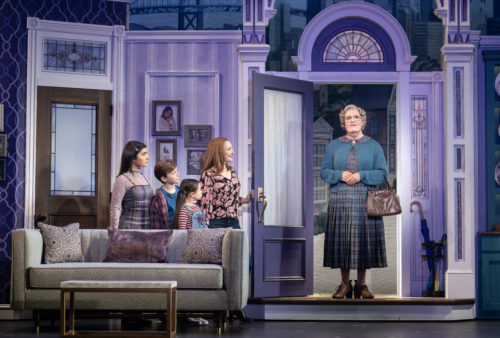
If you haven’t seen the Mrs. Doubtfire movie, it’s easy to stream online and is worth watching. The story is that Daniel and Miranda get a divorce, and she wins full custody of their three children. Desperate to get a chance to be with them, Daniel enlists the help of his make-up artist brother and develops a disguise: that of the Scottish nanny Mrs. Doubtfire. He manages to get hired by his ex-wife and hilarity ensues. This secret identity provides slapstick costume changes, sincere discussions of family and divorce, and many, many jokes.
The biggest question I had before seeing the November 7th show at TPAC was if Rob McClure was going to do a Robin Williams impression the way recent trailers have made it seem that Wonka might be a feature-film length weak Gene Wilder impression. The answer is a clear no. McClure plays his own character. He carries the show, being funny, good at physical comedy, and fantastic at doing voices, of which he does many. My other favorite cast member was Leo Roberts, who plays Stuart, the man Miranda dates after the divorce. He was the most likable character in the play and played an excellent straight man to McClure’s Doubtfire.
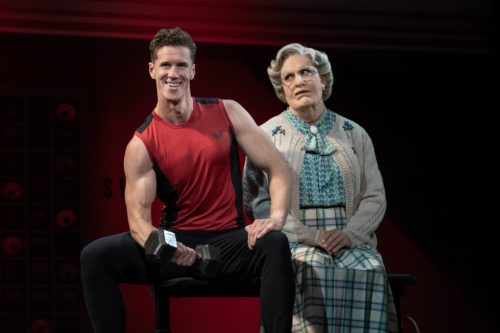
Photo by Joan Marcus
The musical covers the same story but it does not try to be the 1993 film. It is set in the present, and the only bits that feel dated are a plot point about a live local children’s television program and occasional “flossing;” I double-checked with my high school brother, and he said the dance move is cringy now. Most of the story beats are the same in the musical and the film with a few small exceptions; in the musical Miranda (Maggie Lakis) is now a businesswoman opening a fitness clothing line, and a buff Stuart (her new boyfriend) owns a line of fitness studios. This added the joy of seeing Mrs. Doubtfire join the fashion catwalk as a last-minute replacement plus-size model. There is a new subplot, but it is basically meaningless: Daniel’s brother and his husband mention that they want to adopt, and then later they show up with a baby. Problem mentioned, problem solved.
This adaptation did not fix the (for me, insurmountable) flaw of the film, which is that Miranda, the mother, is portrayed as a sympathetic character, and Daniel as the one who has to learn his mistakes. That would be fine– it’s realistic to show two divorced people both partly in the wrong, partly in the right– except the whole conceit of the story relies on her ignoring his pleas to see his children and ignoring her children’s pleas to see their father, and then hiring a stranger to watch them instead. Such unloving selfishness remains unaddressed, diminishing the impact of the heartfelt moments of the story.
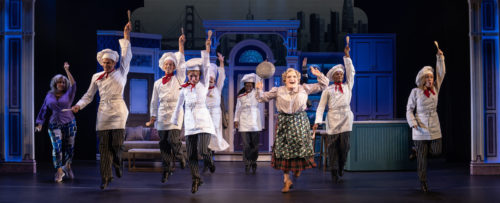
The music was not terribly memorable, except for the comedy numbers, all of which I enjoyed. My favorite (and I think the crowd’s favorite) was “Easy Peasy,” when Daniel as Mrs. Doubtfire struggles to cook dinner for the first time. He asks Siri to play a recipe video and has to keep looking new things up when told to do things like “spatchcock” a chicken. Advice-giving cooks dance around the stage and are even interrupted by an unskippable ad. Another song, “It’s About Time,” has him playing with puppets and a loop machine on a children’s show set. “He Lied to Me,” is a goofy flamenco song performed at the restaurant finale scene, and makes for a better reveal than the film’s. In the movie, the secret identity is revealed when Stuart’s pepper allergy makes him choke on a piece of shrimp (unclear on how that works) and Daniel’s disguise gets ruined after giving him the Heimlich maneuver. The musical changes the reveal, the disguise getting accidentally torn off while dancing. The music and an effective long pause make the moment more shocking.
This is a well-done musical with many enthusiastic ensemble dance numbers, and for fans of the classic film, it hits all the good moments and adds a few new ones. For people that don’t know the story (my teenage brother who accompanied me to the show has not seen the film), it’s an adaptation that stands on its own two feet.
Shows continue at TPAC until 11/12. For tickets and more information: https://www.tpac.org/event/2023-11-07-to-2023-11-12-mrs-doubtfire/ and for information about the national tour Tour – Mrs. Doubtfire.
In Correspondence from San Francisco
Les Illuminations by Benjamin Britten and The Planets by Gustav Holst

(performed in Davies Symphony Hall, San Francisco, California, October 27, 2023. San Francisco Symphony, Elim Chan, conductor; Andrew Staples, tenor.)
Greatness makes itself known, even to the least experienced music lover. The San Francisco Symphony, under the powerful, yet nuanced leadership of Elim Chan, proved itself a match for magnificent works by two of Britain’s great composers, Benjamin Britten and Gustav Holst.

Chan, a petite force of nature in a ruched black satin jacket over a bell-shaped tulle shirt wearing stylish boots, came ready for action. Without a conductor’s baton or a wasted gesture, she used her entire upper body to lead SFO. From fully expansive arm movements in fortissimo passages to the merest trembling of her fingertips in pianissimo passages, Chan redefines conducting techniques. But clearly, the orchestra had read her entire dictionary. A swipe to the right and the trombones heralded their power; a wave to the left and the magical concoction of harps and glockenspiel wove its spell. Chan took two very different works and gifted them to the audience adroitly wrapped in skill, elegance, and authority.
Les Illuminations, for high voice and strings, represents Britten’s ongoing pilgrimage toward effective text setting, succeeding in a song cycle of French poems by Arthur Rimbaud, who served as a foundational influence on literary surrealism. SFO presented a gorgeous variety of sonorities in both the strings and guest tenor, Andrew Staples. After a few too many heldentenor moments in the opening songs, Staples found his voice, so to speak, and delivered power and subtlety, as required.
The strings, equal partners in this venture, ebbed and flowed with their own power and subtlety. One of the loveliest moments came in the third movement. “Phrases” with the text “I have hung ropes from bell-tower to bell-tower; garlands from window to window; golden chains from star to star” is sung in near monotone staying soft until a glissando down to the final nearly silent words “and I dance.”
“Antique,” an homage to the god Pan, has the strings strumming quasi chitarra [like a guitar], with spacious vocal melismas on “night” in the final phrase “…tinkling sounds run through thy arms…Walk at night, gently moving this thigh, the other, the left leg.” As an example of the partnership between the strings and voice, the principal violin ends the movement with a celestially high solo.
“Royauté” and “Marine,” were more down to earth with a delightful scene of village royalty celebrating young love followed by playful staccato that alternates with thrilling runs and whirling notes where “whirlpools of light” swirl down to a jaunty pizzicato. The entire piece ends with gently discordant harmonies expertly dying away into resignation at the departure of . . . unstated rumors and visions, ending this tour de force with the ultimate in virtuosic restraint.
*****

Holst intended The Planets to represent astrological influences, excluding Earth as having no significance in this realm. So many sci-fi movies use the first movement—Mars, Bringer of War—that the audience understandably exploded as it ended. Daring to begin an eight-movement piece with such unrelenting energy, Holst met his own challenge, moving immediately to the ethereal delicacy of Venus—Bringer of Peace. While the trombone section and two timpanists led the way in Mars, Venus featured glistening blends of gorgeous tones in the strings and woodwinds.
From the serenity of Venus came Mercury—the Winged Messenger—a delightful scherzo, an interlude before the drama of Jupiter—Bringer of Jollity. As the second most well-known movement, Jupiter had the largest orchestration, keeping faith with The Planets‘ subtitle: “for large orchestra.” The huge forces featured 30 violins and eight basses, four each of flutes, oboes, and bassoons (for comparison, most Beethoven symphonies have no more than two of each), and seven percussionists. Jovial Jupiter moves from commanding force embellished with the cymbals and triangle to poignant fervor. Concerning this latter, the lovely melody in the style of a hymn has now become a hymn tune called “Thaxted” in use for Anglican services and is also set to secular lyrics.
Once again, the players’ tone qualities equaled the composer’s imaginative orchestration, like the mysterious drones in the basses paired with two harps for Saturn, the Bringer of Old Age. The same applies to Neptune—the Mystic—the final movement with the lovely tone of the entire flute section paired with the aforementioned harps, glockenspiel, and suspended cymbals. A hidden choir of sopranos and altos illuminated the unearthly sensuality of this orchestration giving the audience a real-time sense of timeless wonder.
Between Saturn and Neptune, Uranus—the Magician— begins dramatically, featuring the seven-member percussion section. Xylophone, two timpanists, bass drum, cymbals, and more, the active section made their own magic with the myriad tools at their disposal. The enthusiastic audience recognized this section with vigorous applause, as they did for the cellos, who had their own acknowledgment, separate from the rest of the string section.
Once Holst wrote to Ralph Vaughn Williams, another great British composer: “You have really done it…you have reached the heights but you have taken your audience with you.” With Holst himself as the main pathway toward thrilling performances, Chan and the San Francisco Symphony did indeed reach the heights, taking each member of the audience with them.
Oz Arts Presents
A Riotous Revelry: The 9th Annual Festival of Ghouls
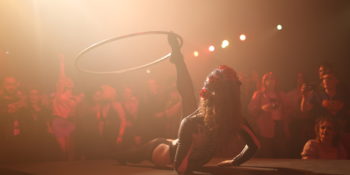

Saturday the 28th of October was the 9th annual Festival of Ghouls at Oz Arts. The dark and spooky room was decorated like the bowels of hell, with a huge game wheel listing the nine levels of hell (according to Dante’s “Inferno”): limbo, lust, gluttony, greed, wrath, heresy, violence, fraud and treachery. In place of an arrow on the wheel was a bright red pitchfork. At the bar, the special cocktail of the night was Satan’s Kiss: a delicious mixed drink made with either vodka or tequila and set on fire. There was a free photo booth where you could go a get your picture taken and texted to you with a Festival of Ghouls frame.
The first opening act, Ergo, Bria, was equal parts angry and powerful. Who doesn’t love kicking nazis in the face? The second opening act, Basic Printer, describes their music as gloitchpop. Synthy and quirky, my favorite song was IGF. Next, were the costume competitions, one for couples and one for singles. Anyone who had been given a pin during the night was invited to come on stage for the audience to vote on the winners. There were some truly amazing and creative outfits. The loudest cheers for the couples category went to a group of three dressed as Marty McFly, Doc Brown, and a bush that the DeLorean drives through. The singles competition was won by a person dressed as Marge Simpson, complete with yellow body paint. In my opinion, they missed out by neglecting to give a pin to a particularly unique and luminous Poison Ivy costume.
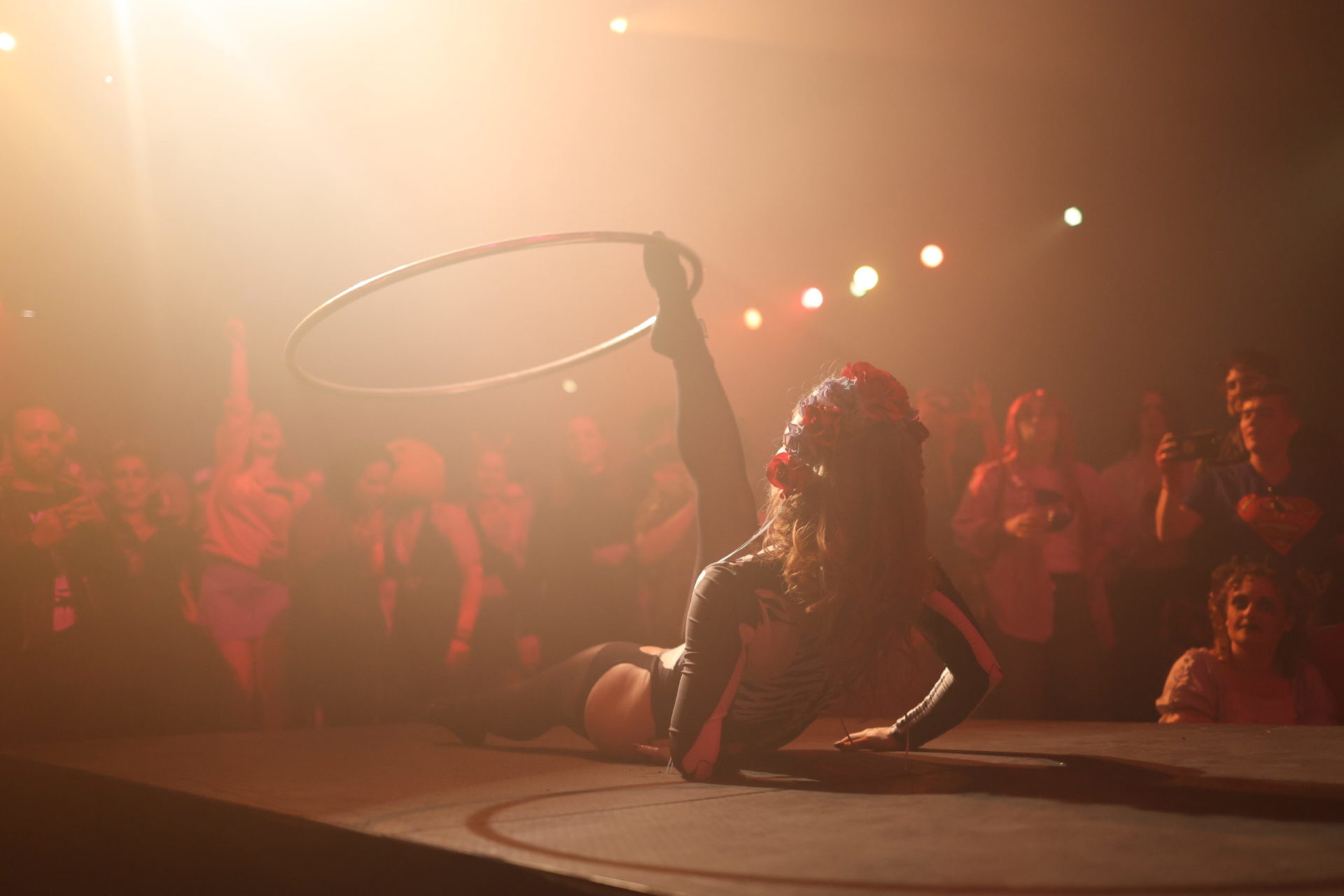
Fable Cry, the headlining band and hosts for the evening included: Zach Ferrin/Zac Fable, vocals and guitar; Mallory Kimbrell/Wicked Ida, vocals; Loren Fernandez Valentin, vocals and 12-stringed bass; Jillian LaFave, vocals and keys; and Andrew Core on the drums. They were all dressed as deliciously dazzling devils with Zach Ferrin as Satan himself, guiding us through our arrival in hell. “Hello, all you sinners and heathens,” he welcomed us, “…in case you haven’t noticed, you’re dead!” Wicked Ida was the charismatic game master, inviting up audience members with a demonically dimpled smile to spin the wheel. They sang different songs for the levels of hell including newer songs like “Screaming is Believing” along with old favorites like “Fancy Dancing.” Their music is a unique blend of multiple genres like metal, punk and rock with a spooky tone. The members of Fable Cry are a truly talented group with amazing stage presence. Ferrin brought such great energy to the stage that people were crowding around to get closer.
Many of the musical numbers were enhanced with burlesque and drag performances by Back to Black Burlesque, Gidget Bardot, and Viktor Blackwood as well as circus performances by Suspended Gravity. These performances were sensual, athletic, and theatrical, drawing huge cheers and applause from the audience. My only critique for the evening was the occasional feedback and that the sound in the room was unbalanced and slightly top heavy, especially during the opening acts.
If you’ve ever read Dante’s “Inferno,” you know that Dante takes a tour through hell to be shown all the possible sins and what fate lies ahead if you commit those sins. It is a cautionary tale meant to keep us from making the prideful mistake of thinking that any mortal is above sin. Fable Cry takes this dark tale and twists it into a wickedly fun gameshow. The journey through hell isn’t horrifying, it’s fun! Why be afraid of hell when all the best people are there and Satan will welcome you with open arms and song. This creative take on the famous poem makes me excited for what Fable Cry might come up with for year 10. Come on down to next year’s Festival of Ghouls to find out!
In Nashville Premieres:
Mrs. Doubtfire Coming to TPAC!
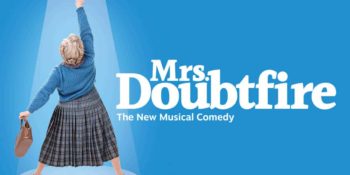
Fans of classic movies have another musical reason to go to TPAC this season; Mrs. Doubtfire is now a Broadway musical! This is an internationally acclaimed hit musical critics call “wonderful, heart-warming, and laugh-out-loud funny” (Manchester Evening News) and “a feel-good, family-friendly comedy that delivers” (The Hollywood Reporter). Based on the beloved film and directed by four-time Tony Award® winner Jerry Zaks, MRS. DOUBTFIRE tells the hysterical and heartfelt story of an out-of-work actor who will do anything for his kids. It’s “the lovable, big-hearted musical comedy we need right now,” raves the Chicago Tribune – one that proves we’re better together.

The North American Tour has Rob McClure reprise his Tony-nominated Broadway performance on tour alongside co-star (and real wife) Maggie Lakis. Premiering December 2019, the Broadway production of “Mrs. Doubtfire” was repeatedly stopped and started due to COVID-19, and played its final performance at the Stephen Sondheim Theatre on May 29, 2022. The performances at TPAC will be one of the tour’s two visits to Tennessee, returning to the state in March to perform in Memphis.
Besides the regular shows, TPAC is also hosting an “Arts Appetizer” on October 8th, a pre-show discussion with Nashvillian Wayne Kirkpatrick, co-writer of the music for Mrs. Doubtfire, and cast members from the touring Broadway production. The audience can learn about the process of adapting the show from a movie to a musical while enjoying box dinners from The Nashville Food Project.
Performances are November 7-12 at TPAC’s Andrew Jackson Hall. For tickets and more information: Mrs. Doubtfire | Broadway Shows in Nashville at TPAC
For tickets and information about the Mrs. Doubtfire Arts Appetizer November 8th: TPAC’s InsideOut: Arts Appetizer Mrs. Doubtfire
For more information on the Mrs. Doubtfire North American Tour: Mrs. Doubtfire
The NCMS’s Opening Night:
Watercolor, Reverence, and some Drama.


The Nashville Chamber Music Society (NCMS) presented an outstanding opening-night performance of their current season featuring cellist and NCMS founder MaryGrace Bender, flutist Danielle Maeng, and pianist Brendan Jacklin (NCMS, performer’s bios, and other relevant links listed are below). In my short conversation with the trio after the performance, Bender gave an account—charmingly reiterated in “Our Story” on the NCMS website—of what ultimately led to the group’s formation: “I got to grow up in this wonderful town [Nashville] and fell in love with music because of the beauty it brings to the world and the sweet community that comes along with it.” Bender’s simple and refreshing explanation reminds us that such ideas—ones often considered naïve—can ignite and grow, ultimately having a far-reaching positive effect on communities. Bender had a vision of bringing music she loves to her community, and the group’s first cozy and unlikely performance venues—unlikely for “classical” chamber music—were local coffee shops. However, NCMS performances eventually advanced to include more significant, formal performance spaces. According to the group’s website, NCMS is a 501(c)(3) nonprofit organization partnering with local schools, retirement homes, homeless shelters, and other venues “to bring artistic excellence and beautiful experiences” to Nashville and surrounding areas.
On Friday evening of October 27, 2023, the NCMS did just that! They brought to their community a beautiful musical experience at Covenant Presbyterian Church in Nashville where they are currently in residence. The church’s expansive and cathedralesque sanctuary was utilized as a backdrop for the performance since its footprint was modified taking place within the choir—or the portion of the sanctuary just behind the alter—with the audience facing out toward its airy nave—or the main section where the congregation sits. The audience’s closer proximity to the evening’s performers provided a more enlivening and intimate experience—perhaps like a variation of a similar proximity in coffee shops—within such a voluminous space.

First, on their program, NCMS performed Philippe Gaubert’s (1879–1941) Trois Aquarelles—or Three Watercolors—a trio for flute, cello, and piano that is exemplary of the general soundscape of French art music in the early twentieth century. Gaubert, a flutist, by the end of World War I, was a fixture in 1920s French musical life, and his Trois Aquarelles is evidence of his being influenced by composer contemporaries such as Claude Debussy (1862–1918), Gabriel Fauré (1845–1924), and Maurice Ravel (1835–1937). Just as French impressionistic painters used watercolors, allowing lines on canvas to bleed into one another, obscuring texture, so does the opening of the first movement, “Par un clair matin” (On a Clear Morning). In the performance, Jacklin produced a beautiful foundation of aural color consisting with washes of transformational harmonies while Maeng and Bender entered, playing a rhythmically complex unison melody.
The blending between the three performers was impeccable, and their individual timbres became less exclusively discernable, giving a successful impression of a watercolor painting. The second movement, “Soir d’Automne” (Autumn Evening), featured exquisitely played contrapuntal lines between flute and cello, was skillfully maneuvered, requiring focused non-spoken communication between players. The third movement, “Sérénade” (Serenade), featured an expected tinge of exoticism familiar to French composers of the period. Debussy’s epiphany reached after hearing Indonesian gamelan music at an East Asian exhibit at the 1889 Exposition Universelle—better known as the 1889 Paris Exposition—changed the trajectory of the composer’s music, which further influenced the music other French contemporaries. Thus, the exotic is prominently discernable in Gaubert’s third movement here. The faster, rhythmically intricate, and virtuosic lines include simultaneous resonances of the exotic generally, hinting at sounds of East Asia and even Andalusia.

Full Circle 50, composed by Jack Heggie (b. 1961), was commissioned by Elizabeth King in 2019 to celebrate the fifty-year performing career of acclaimed flutist Carol Wincenc. The movement, “Golden,” centers on a lyrical duet between the cello and flute. Songlike—a proper description since “Golden” is said to be indicative of Heggie’s art-song style. This movement was especially fitting for the performance space; the reverent quality of “Golden” was charmingly enhanced for audiences by the spiritual iconography seen all around the church’s sanctuary. The more spritely “Travel Travail” is an aural depiction of an artist’s life. The harmonically stagnant piano ostinato Jacklin produced elicited a sense of freedom and bustle. Extended techniques used by Jacklin included knocking on the underside of the piano, signifying how artists perpetually knock on doors to find opportunities. Less to do with hummingbirds, Heggie wrote “Hummingbird” to sonically depict Raymond Carver’s poem of the same name, sounding static, introspective, and languid. Jacklin begins the “Hummingbird” by manually plucking a piano string—its opening ‘C’ pitch. The last movement, “Full Circle,” develops a musical theme using a collection of styles from earlier eras. “Full Circle,” in part, breaks from the more contemporary style of the proceeding movements using devices harkening back to the Baroque—and maybe early Classical even—such as a system of melodic and harmonic sequence. All performers showed their musical maturity and excellent silent communication skills through a gradual and culminating accelerando toward an exhilarating finish.
Regarding the Trio for Piano, Flute, and Cello by Carl Maria von Weber (1786–1826)—well, it was Weber. Credited for ushering German Romantic opera, Weber wrote ten operas, including Der Freischutz (1821) and Oberon (1826), for which he is best known. This last piece of the program was an enjoyable contrast to the Gaubert and Heggie since it features Weber’s flair for the dramatic. All performers irreproachably handled the many virtuosic sections of the piece seemingly with ease and stylistic accuracy. When preparing the Weber, Bender recalls how the performers drew the vocal style indicative of the composer’s operatic works.
Overall—a great evening; I encourage anyone to attend any one of NCMS’s performances. An upcoming performance to note will be held at the Steinway Piano Gallery on Sunday, November 12, 2023. See the NCMS website for details that this and other upcoming performances.NCMS: https://www.nashvillecms.org
From Clarksville
Stanley Yates, The Farewell Concert?
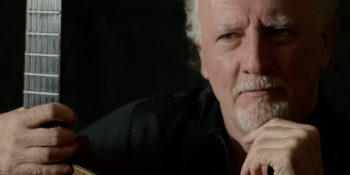
Years ago I was sitting in the flute section of a regional orchestra in California. The inventive Board had hired an up-and-coming acolyte of the Boston Symphony’s famed Seiji Ozawa to conduct our next concert. Kent Nagano, now internationally respected in his own right, started our first rehearsal with a story of his first time conducting the BSO. They were reading through an extremely challenging contemporary score he had studied for months. When the read-through ended, he stood there stunned. Panicked thoughts ricocheted through his head. It was perfect! They’re so good! What could I possibly have to say?
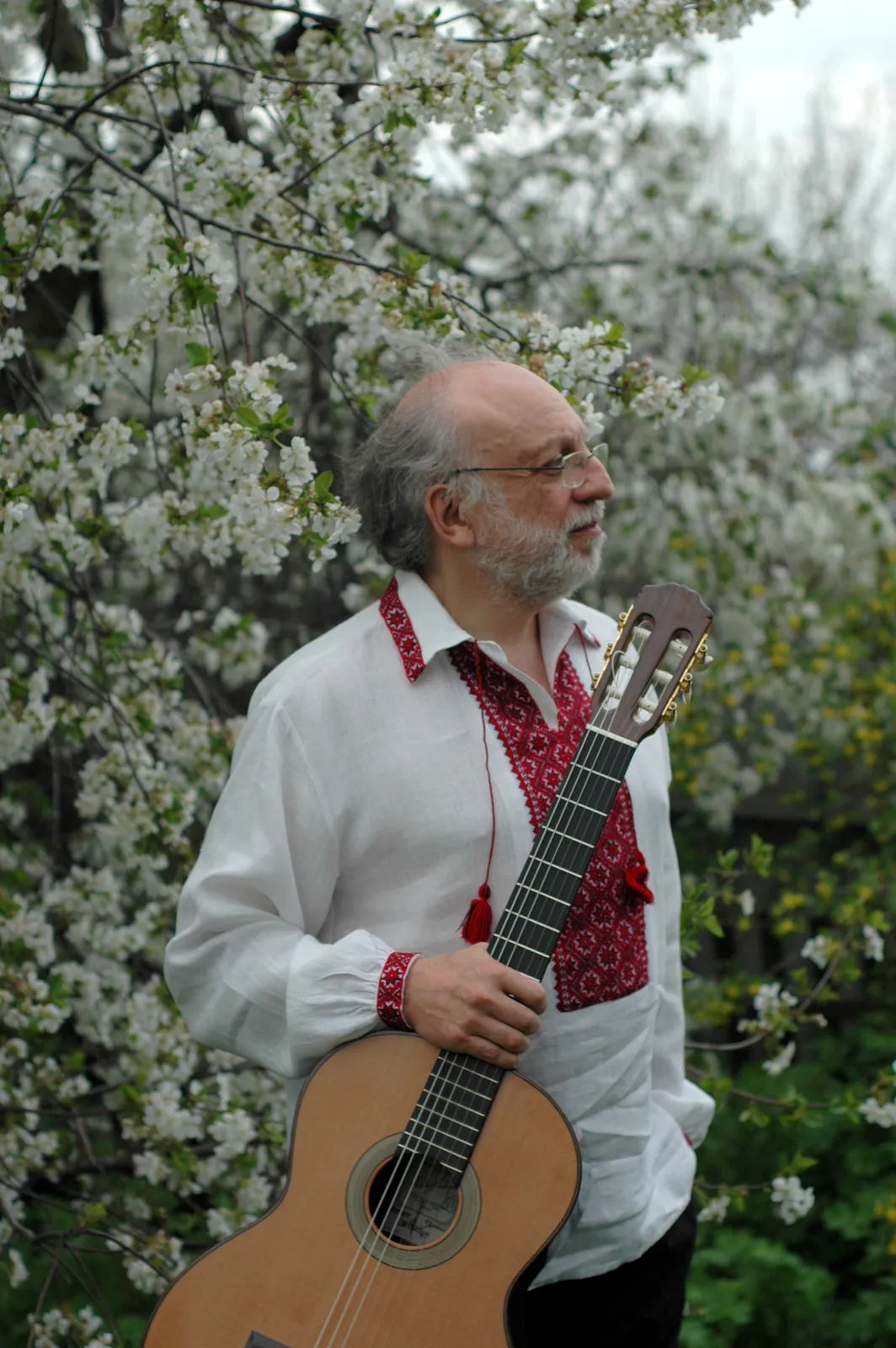
Listening to Stanley Yates, internationally respected guitarist, this memory returned in full force. It was perfect! He’s so good! What could I possibly have to say? But, like Nagano, once I calmed down from the stunned silence of my thoughts, I realized that pure excellence had initially overwhelmed my powers of observation. For one of the rare times in my experience, I could delve into ambrosial details.
The recital, performed in Clarksville TN on October 17, 2023, memorialized the historical development of guitar repertoire, a tombeau de guitar, if you will. Opening with 16th-century lutenist-composer John Dowland, moving through 19th-century guitarist Fernando Sor, into eminent 20th-century composers whose primary instrument was not a guitarist (Manuel de Falla, Heitor Villa Lobos, Enrique Granados), ending as it began with guitarist-composers, but this time the 21st-century versions: Leo Brouwer, Stěpán Rak, and José Luis Merlin.
Typically, I don’t enjoy modern players performing my research specialty, Renaissance dance music. All too often, they bring a 19th-century uber-emotional sensibility to the works while dismissing the rhythmic and tempo aspects that define dance. I was delightfully surprised that, after a lovely free introduction, Yates maintained a gentle sense of pulse into Dowland’s pavane (a slow processional dance), mostly reserving the free ornamentation for cadential moments where free-rhythm bows to noble partners would have occurred. Additionally, each internal line came through with crystalline clarity, a remarkable feat.
I’m not sure why, but Yates apologized in advance for the Sor. Granted, the “Fantaisie élégiaque” is a somewhat extended piece, a fifteen-minute one-movement work, but I wondered if, though charmingly done, it could be seen as a bit patronizing. The Clarksville audience is increasingly sophisticated and, in fact, this was the first performance since I’ve returned to Tennessee where the audience did not interrupt works with applause in inappropriate places.

The Sor, in two sections, much like an operatic pairing of the free recitative and its rhythmic aria, opened with sturm und drang [storm and stress] elements, which the guitar’s natural delicacy transformed into a more galant style. In the funeral march that followed Yates skillfully retained the well-defined contrapuntal technique used in the Dowland.
The quartet of “Latin” pieces by Spaniards de Falla (Homage a Debussy) and Granados, Brazilian Villa Lobos (Etude #8), Cuban Brouwer (Elegie de la Danza) exuded elegance and, in the case of the Granados’ “Orientale,” a tender melancholy. I began to wonder if the performance was “too safe.” It may be almost churlish to question non-stop excellence, but especially in the Latin pieces with occasional flamenco or fandango influence, some of the expected fire seemed missing.
However, any concerns on this front were mitigated by the Rak and, in particular, three encore pieces by Argentinian José Luis Merlin. These works allowed the audience to glimpse a more adventurous Yates, one open to cultures outside classical Western European tradition, one with the wisdom to recognize and the bold willingness to promote contemporary work of the highest quality like Rak’s “Czech Tales.” Its atonal spots added spice to the charming playfulness with a touch of melancholy typical of Eastern European music, a reminder that European fairy tales like those of the Brothers Grimm were far more brutal than the sugarcoated Disney-fied versions. Tapping rock rhythms on the guitar’s body brought the music up to date.
Three works from Merlin’s Suite de Recuerdo [Suite of Memories]—Evocación, Carnevalito, Joropo—evoked my own souvenirs of Peru. The little carnivals all over Cusco and women swirling their colorful skirts as they danced the joropo were a perfect finish for an afternoon of elegant professionalism swirling with colorful excellence.

